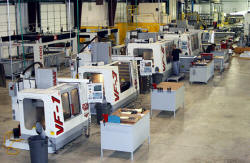Blitzing To Disaster
What Happens When Kaizen Blitzing Replaces Strategy
Aircraft Component Machining
 A
smaller but well-known aircraft company attempted to implement Lean Manufacturing for their
machine shop and subassembly operations. The Kaizen Blitz was their primary approach. They
employed consultants who came in with the usual panoply of edicts and pronouncements:
A
smaller but well-known aircraft company attempted to implement Lean Manufacturing for their
machine shop and subassembly operations. The Kaizen Blitz was their primary approach. They
employed consultants who came in with the usual panoply of edicts and pronouncements:
-
Inventory is evil and must be eliminated regardless of all other considerations.
-
The primary measure of work-cell performance is throughput time.
-
Machine utilization is of no consequence and should be ignored.
-
Work-cells must have a straight-through flow for all products.
-
Work-cells must have one-piece flow.
-
Low-tech, manual machine tools are superior to high-tech NC equipment.
-
Lot sizes must be cut drastically.
 These
edicts apply to many manufacturing situations including this particular manufacturer's
subassembly cells. Indeed, the subassembly cells functioned quite well.
These
edicts apply to many manufacturing situations including this particular manufacturer's
subassembly cells. Indeed, the subassembly cells functioned quite well.
Things did not work so well in machining. Here, a very low-volume, high-variety product mix combined with the above beliefs brought the following results:
-
One Piece Flow combined with a disregard for equipment utilization resulted in cells that were paced to the slowest operation on each part thus reducing effective capacity.
-
Straight-through flow precluded many parts from a particular cell. These inconvenient parts were simply outsourced.
- Since Lean efforts were restricted to Kaizen Blitz' at the cells, no effort was made to provide purchasing the tools they needed to monitor inventories. With many more parts now being outsourced, inventories of purchased machinings mushroomed.
- Failure to adequately implement setup reduction brought even less capacity as lot sizes were reduced.
-
Machining cells were initially tied to particular subassemblies rather than families of similar piece parts. This resulted in sub-optimum cells and limited the number of parts available to a workcell. Many cells were starved for work.
-
Operations were taken off of NC equipment and replaced by a series of operations on manual machines. The multiple fixtures produced tolerance buildups and created severe quality problems for some items.
-
Eventually, so many parts were outsourced and so little produced that the shop could not cover fixed cost. This did not seem readily apparent, however, because of the fixation on throughput time and WIP as the only significant metrics.
The overall result was layoffs, higher inventories, an unprofitable cost structure, management changes, and severe pressure from the corporate masters. The guiding beliefs discussed here derive from Toyota's JIT starting in the early 1950's. Such beliefs were useful for Toyota and similar manufacturers. They do not apply to all situations.
A low-volume, high-variety machine shop is one situation where these guiding beliefs do not apply directly.
Home Water Purification Manufacturing
The company in this example manufactured a wide variety of commercial and home water purification products. Some were quite simple, others fairly complex. A wide variety of injection-molded parts were made onsite.
Over the previous several years, the company had initiated over 150 Kaizen Blitz'. Many of their cells and small production lines seemed well designed and effective but the overall funcioning of the factory was very poor. Management, it seems, were obsessed with the concept of the kaizen event and ignored many of the larger issues. Team development, Total Quality, Setup Reduction, Lean Scheduling, inventory reduction, and overall layout planning had been ignored. The results:
-
Good Productivity Within Cells
-
High Inventories
-
Complex Material Flows External To Cells
-
Messy, Fragmented Storage Areas
-
Quality Problems
 In addition, many people in the organization were frustrated with the constant pressure for
instantaneous results, the lack of important fundamental changes, and the diminishing returns
from each subsequent Blitz.
In addition, many people in the organization were frustrated with the constant pressure for
instantaneous results, the lack of important fundamental changes, and the diminishing returns
from each subsequent Blitz.
The executive who promoted the overuse of the Blitz had recently departed. A Strategos consultant then conducted a 2-day seminar, Facility Design for Lean Manufacturing. The intent was to rationalize the macro-layout.
During this seminar, the managerial team also began to think through their Manufacturing Strategy. They began to develop the fundamental skills and knowledge that would eventually lead to a highly successful manufacturing operation.
Other Kaizen Event Pages:
■ ■ ■ ■ ■ ■ ■


